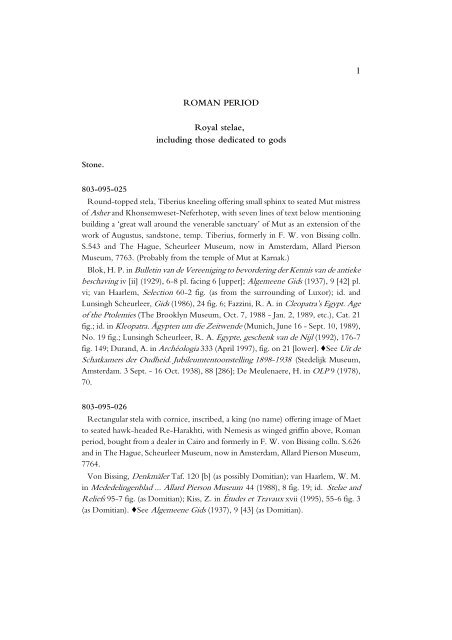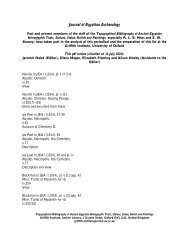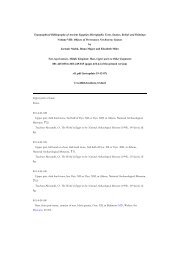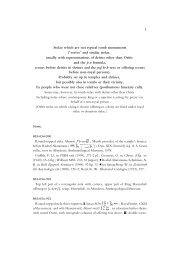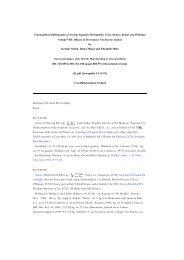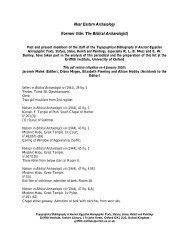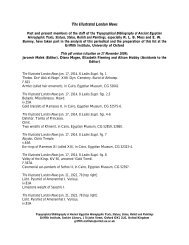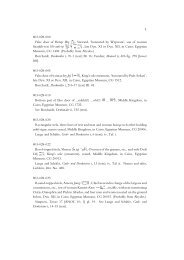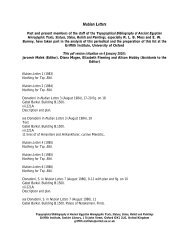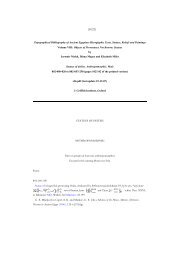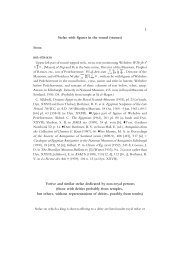1 ROMAN PERIOD Royal stelae, including those dedicated to gods ...
1 ROMAN PERIOD Royal stelae, including those dedicated to gods ...
1 ROMAN PERIOD Royal stelae, including those dedicated to gods ...
Create successful ePaper yourself
Turn your PDF publications into a flip-book with our unique Google optimized e-Paper software.
S<strong>to</strong>ne.<br />
803-095-025<br />
<strong>ROMAN</strong> <strong>PERIOD</strong><br />
<strong>Royal</strong> <strong>stelae</strong>,<br />
<strong>including</strong> <strong>those</strong> <strong>dedicated</strong> <strong>to</strong> <strong>gods</strong><br />
Round-<strong>to</strong>pped stela, Tiberius kneeling offering small sphinx <strong>to</strong> seated Mut mistress<br />
of Asher and Khonsemweset-Neferhotep, with seven lines of text below mentioning<br />
building a ‘great wall around the venerable sanctuary’ of Mut as an extension of the<br />
work of Augustus, sands<strong>to</strong>ne, temp. Tiberius, formerly in F. W. von Bissing colln.<br />
S.543 and The Hague, Scheurleer Museum, now in Amsterdam, Allard Pierson<br />
Museum, 7763. (Probably from the temple of Mut at Karnak.)<br />
Blok, H. P. in Bulletin van de Vereeniging <strong>to</strong> bevordering der Kennis van de antieke<br />
beschaving iv [ii] (1929), 6-8 pl. facing 6 [upper]; Algemeene Gids (1937), 9 [42] pl.<br />
vi; van Haarlem, Selection 60-2 fig. (as from the surrounding of Luxor); id. and<br />
Lunsingh Scheurleer, Gids (1986), 24 fig. 6; Fazzini, R. A. in Cleopatra’s Egypt. Age<br />
of the P<strong>to</strong>lemies (The Brooklyn Museum, Oct. 7, 1988 - Jan. 2, 1989, etc.), Cat. 21<br />
fig.; id. in Kleopatra. Ägypten um die Zeitwende (Munich, June 16 - Sept. 10, 1989),<br />
No. 19 fig.; Lunsingh Scheurleer, R. A. Egypte, geschenk van de Nijl (1992), 176-7<br />
fig. 149; Durand, A. in Archéologia 333 (April 1997), fig. on 21 [lower]. ‚See Uit de<br />
Schatkamers der Oudheid. Jubileumten<strong>to</strong>onstelling 1898-1938 (Stedelijk Museum,<br />
Amsterdam. 3 Sept. - 16 Oct. 1938), 88 [286]; De Meulenaere, H. in OLP 9 (1978),<br />
70.<br />
803-095-026<br />
Rectangular stela with cornice, inscribed, a king (no name) offering image of Maet<br />
<strong>to</strong> seated hawk-headed Re-Harakhti, with Nemesis as winged griffin above, Roman<br />
period, bought from a dealer in Cairo and formerly in F. W. von Bissing colln. S.626<br />
and in The Hague, Scheurleer Museum, now in Amsterdam, Allard Pierson Museum,<br />
7764.<br />
Von Bissing, Denkmäler Taf. 120 [b] (as possibly Domitian); van Haarlem, W. M.<br />
in Mededelingenblad ... Allard Pierson Museum 44 (1988), 8 fig. 19; id. Stelae and<br />
Reliefs 95-7 fig. (as Domitian); Kiss, Z. in Études et Travaux xvii (1995), 55-6 fig. 3<br />
(as Domitian). ‚See Algemeene Gids (1937), 9 [43] (as Domitian).<br />
1
2<br />
803-095-035<br />
Round-<strong>to</strong>pped stela, winged disc, lion and hawk in lunette, and below, a king<br />
(‘pharao’) offering wine <strong>to</strong> Horus, Heket, Khnum with a ram, and Satis, grey granite,<br />
Roman Period, in Berlin, Ägyptisches Museum, 8166. (Acquired in Girga.)<br />
Iwas, W. in Wissenschaftliche Zeitschrift der Humboldt-Universität zu Berlin.<br />
Gesellschafts- und Sprachwissenschaftliche Reihe xxxi (1982), 221-2 Abb. 218-19,<br />
221, 223-6 on 400-2 (as Augustus). See Ausf. Verz. 332 (as Dyn. XXV or Roman<br />
and in ‘Nubian style’); Führer durch das Berliner Ägyptische Museum (1961), 82 (as<br />
about 100 BC); Kiss, Z. Études sur le portrait impérial romain en Égypte (1984), 105.<br />
803-095-040<br />
Round-<strong>to</strong>pped stela, three registers, I, a king (‘pharao’) offering <strong>to</strong> Min, Isis(?) and<br />
a young god (Harsiesi?) (no names), II II, II<br />
a king (‘pharao’) offering <strong>to</strong> a god wearing<br />
white crown (Khons?), Hathor(?) and Sobek (no names), III III (<strong>to</strong>p part only), remains<br />
of scene with two deities before a crocodile, sands<strong>to</strong>ne, Roman Period, in Berlin,<br />
Ägyptisches Museum, 18544.<br />
803-095-042<br />
Small round-<strong>to</strong>pped stela, bull(?) and bird in lunette, and below, I, a king(?) before<br />
ibis-headed Thoth and baboon on shrine, II II, II<br />
bound captive, Roman Period, in Berlin,<br />
Ägyptisches Museum, 23464.<br />
Cairo, Centre of Documentation pho<strong>to</strong>. S.R., Box 173, 9316.<br />
803-095-050<br />
Round-<strong>to</strong>pped stela with right bot<strong>to</strong>m part missing, Tiberius before ithyphallic Min<br />
and Amun, and remains of three lines of demotic text below, sands<strong>to</strong>ne, temp.<br />
Tiberius, in Cairo, Egyptian Museum, CG 31100.<br />
Spiegelberg, W. Die demotischen Denkmäler i. Die demotischen Inschriften (Cat.<br />
Caire) (1904), 33-4 Taf. vi.<br />
803-095-070<br />
Round-<strong>to</strong>pped stela, Emperor Claudius offering <strong>to</strong> Harpocrates ‘twice great’, ‘the<br />
first of Amun’, and probably Isis (not named), and dedicating temple gate, with two<br />
lines of hieroglyphic texts below, and another two lines of demotic mentioning<br />
Parthenios Prthnjs, son of Pamin P3-mnw, year 9 of Claudius (in demotic text),<br />
sands<strong>to</strong>ne, in Cairo, Egyptian Museum, JE 52970. (Bought in Qûs ., probably from<br />
Qift ..)<br />
Farid, A. in MDAIK 44 (1988), 23-7 [6] Taf. 6 Abb. 6 (as from Qift .).
803-095-100<br />
Rectangular stela with cornice on round-<strong>to</strong>pped background, a king offering incense<br />
and libation <strong>to</strong> composite sphinx, no doubt Tutu, on pedestal, no texts, Roman<br />
Period, in Chicago IL, Field Museum of Natural His<strong>to</strong>ry, A.31666.<br />
Allen, T. G. Egyptian Stelae in Field Museum of Natural His<strong>to</strong>ry (1936), 76 pl. xlii;<br />
Kaper, O. E. The Egyptian God Tutu (2003), 332-3 [S-35] fig.<br />
803-095-200<br />
Round-<strong>to</strong>pped stela, Claudius dedicating temple gate <strong>to</strong> Geb and a goddess, with<br />
two lines of dedication text below and four lines of demotic mentioning Parthenios<br />
Prthnjs, son of Pamin P3-mnw, sands<strong>to</strong>ne, year 9 of Claudius, in Leiden,<br />
Rijksmuseum van Oudheden, F.1969/2.3.<br />
Farid, A. in MDAIK 44 (1988), 28-34 [11] Taf. 7 Abb. 11 (as from Qif t .); Raven,<br />
M. J. Schrift en schrijvers in het Oude Egypte (1996), 5, 10, 83 [34] fig. (as from<br />
Qift .).<br />
803-095-245<br />
Round-<strong>to</strong>pped stela, Tiberius offering image of Maet <strong>to</strong> Khonspekhrod and the<br />
Theban triad, and seven lines of text below mentioning res<strong>to</strong>ration of enclosure wall<br />
of Mut, sands<strong>to</strong>ne, temp. Tiberius, in London, British Museum, EA 1432. (Probably<br />
from the temple of Mut at Karnak.)<br />
Guide (Sculpture), 282-3 [1054] pl. xxxix; Quirke, S. Ancient Egyptian Religion<br />
(1992), fig. 102.<br />
803-095-250<br />
Round-<strong>to</strong>pped stela, Tiberius offering <strong>to</strong> Khonsemweset-Neferhotep and Osiris-<br />
Onnophris, and four lines of text mentioning building a s<strong>to</strong>rehouse (šna), probably at<br />
Karnak, below, sands<strong>to</strong>ne, temp. Tiberius, in London, British Museum, EA 1634.<br />
(Probably from Karnak.)<br />
De Meulenaere, H. in OLP 9 (1978), 72-3 pl. i fig. 1.<br />
803-095-350<br />
Round-<strong>to</strong>pped stela, a king (car<strong>to</strong>uches blank but probably Tiberius) offering two<br />
jars of wine <strong>to</strong> seated Montu-Re lord of On of Upper Egypt and standing Tjenent ‘in<br />
On of Upper Egypt’, sands<strong>to</strong>ne, probably temp. Tiberius, in Rio de Janeiro, Museu<br />
Nacional, Inv. 679 [2417?]. (Probably from Thebes.)<br />
Kitchen, K. A. and Beltrão, M. da C. Catalogue of the Egyptian Collection in the<br />
3
4<br />
National Museum, Rio de Janeiro (1990), i, 112-15 [52]; ii, pls. 105-6.<br />
803-095-600<br />
Round-<strong>to</strong>pped stela, inscribed, rec<strong>to</strong>, a Pharaoh (no name in car<strong>to</strong>uches) before<br />
seated Atum, verso, a king before probably Maet, Re-Harakhti and Atum, sands<strong>to</strong>ne,<br />
Roman Period, at Christie’s in 1969.<br />
Christie Sale Cat. Dec. 2, 1969, No. 127 figs. (as Dyn. XXVI).<br />
S<strong>to</strong>ne.<br />
Tomb <strong>stelae</strong> without royal names<br />
803-097-080<br />
><br />
Round-<strong>to</strong>pped stela, woman Nebtudjat Nbt-wd3t bK , daughter of<br />
B .t<br />
!<br />
Menkhamunre Mnh.-jmn-ra B 1 , Dresser(?) (nms) of Osiris-Sokari in Dendera,<br />
.t<br />
V 4<br />
before squatting Re-Harakhti, Osiris-Sokari, Isis and Anubis (no names), and four<br />
lines of text below, early Roman Period, in Budapest, Szépm u1vészeti Múzeum,<br />
51.2152.<br />
Takácz, G. in Bull. Mus. Hongrois 80-1 (1994), 9-24 cf. 143-56 fig. 1.<br />
803-097-100<br />
Rectangular stela, woman Tashenpawer T3-šrjt-(nt-)p(3)-wr , wearing<br />
! ! # 71DM uraeus on forehead and holding lotus bouquet, in front of table, sands<strong>to</strong>ne, Roman<br />
Period, in Cairo, Egyptian Museum, CG 22232 (JE 37607).<br />
Rowe, A. in ASAE xl (1940), 21 [A. vii] pl. vi (as Nubian and drowned). ‚See<br />
Kamal, Stèles p<strong>to</strong>lémaïques et romaines i, 214 (text) (as goddess).<br />
803-097-105<br />
Lower part of stela with figures in very high relief, man in a Hellenistic style wearing<br />
chi<strong>to</strong>n and himation, flanked by two Sons of Horus (or two figures of Ptah) with<br />
hieroglyphic texts in front of them, and demotic and Greek texts on base, Roman<br />
Period, in Cairo, Egyptian Museum, CG 27541.<br />
Edgar, C. C. Greek Sculpture. Cat. Caire (1903), 39-40 (Greek text only) pl. xxiv.<br />
‚See Pfuhl, E. in Mitteilungen des kaiserlich deutschen archaeologischen Instituts,<br />
Athenische Abteilung xxvi (1901), 299-300.
803-097-150<br />
Round-<strong>to</strong>pped stela with painted decoration, man in adoration before Osiris and Isis,<br />
and two lines of much effaced text at bot<strong>to</strong>m, Roman Period, in Chicago IL, Field<br />
Museum of Natural His<strong>to</strong>ry, A.31687.<br />
Allen, T. G. Egyptian Stelae in Field Museum of Natural His<strong>to</strong>ry (1936), 75-6 pl.<br />
xlii.<br />
803-097-300<br />
Round-<strong>to</strong>pped stela, mummy in barque at <strong>to</strong>p, and below, mummiform figure held<br />
by Anubis before seated Osiris and goddess (probably Isis), with cursive text below,<br />
probably Roman Period, in Lund, Kulturhis<strong>to</strong>riska Museet, 32.168.<br />
803-097-600<br />
Round-<strong>to</strong>pped stela, man and woman facing each other at table under a winged disc<br />
and two udjat eyes, no text, probably Roman Period, in New York, Parke-Bernet<br />
Galleries Inc., in 1970.<br />
Parke-Bernet Sale Cat. April 24-5, 1970, No. 124 fig. (as P<strong>to</strong>lemaic).<br />
Wood.<br />
803-098-250<br />
Round-<strong>to</strong>pped stela decorated on both sides, rec<strong>to</strong>, man in adoration before Re-<br />
Harakhti, Osiris, Isis and Nephthys, and three lines of probably offering text (names<br />
illegible) below, verso, two registers, I, owner in adoration before seated Osiris<br />
followed by Isis(?) and Nephthys(?), II II, II<br />
probably Anubis attending mummy on bier,<br />
painted wood, Roman Period, in Leiden, Rijksmuseum van Oudheden, F.1915/5.1.<br />
Boeser, Beschreibung xiv, 16-17 [22] Taf. vi. See Munro, P. Die spätägyptischen<br />
Totenstelen (1973), 245 [Leiden xiv, 22a, b] (as probably from Thebes).<br />
803-098-300<br />
Round-<strong>to</strong>pped stela of Pashenusiri P3-šrj-(n-)wsjr, Overseer of the treasury of Neith<br />
and Horus the Behdetite, son of Djeho Dd-h . rw , Overseer of the treasury of<br />
i: 4<br />
Neith and Horus the Behdetite, and Nehemse-esi Nh . m-s(t)-3st , bot<strong>to</strong>m<br />
*e`! ! _<br />
part lost, with mummification scene with Anubis, Isis and Nephthys, and 7 remaining<br />
lines below, wood, Roman period, in Newark NJ, The Newark Museum, 25.667.<br />
Auth, S. H. in ARCE Newsletter 120 (Winter 1982), 1, 59 fig. on front cover. ‚See<br />
id. in Ses<strong>to</strong> Congresso Internazionale di Egit<strong>to</strong>logia. Atti (1993), ii, 3, 5 [8].<br />
5
6<br />
803-098-500<br />
Round-<strong>to</strong>pped stela, man in adoration before Horus, Osiris, Isis and Nephthys (no<br />
names), and five lines of text below, wood, Roman period, at Sotheby’s (New York)<br />
in 1989.<br />
Sotheby (New York) Sale Cat. Nov. 29, 1989, No. 400 fig.<br />
Votive <strong>stelae</strong> and plaques <strong>dedicated</strong> by non-royal persons<br />
Stelae on which a king is shown offering <strong>to</strong> a deity are listed under royal <strong>stelae</strong> or<br />
donation <strong>stelae</strong> (except for votive <strong>stelae</strong> where a king is acting ‘by proxy’<br />
S<strong>to</strong>ne.<br />
803-099-005<br />
on behalf of a non-royal person)<br />
Round-<strong>to</strong>pped stela, bot<strong>to</strong>m part lost, man libating and censing before Ihet[-wert]<br />
cow (mother of Buchis bull), two lines giving her death as year 4 of Licinius and death<br />
as year 8 of Constantine, and another two lines of text below, sands<strong>to</strong>ne, temp.<br />
Constantine, in Aberdeen, Anthropological Museum, 1619. (Probably from Armant.)<br />
Capart, J. in Chron. d’Ég. xv (1940), 47-50 fig. 2 (as temp. Maximinus Daia);<br />
Grenier, J.-C. in BIFAO 102 (2002), 247-56 figs. 1, 3 (as 1). ‚See Reid, R. W.<br />
Illustrated Catalogue [etc.] (1912), 204.<br />
803-099-010<br />
Rectangular stela with cornice, representation of shrine and Agathos Daimon uraeus,<br />
no texts, Roman Period, in Alexandria, Graeco-Roman Museum, 3156.<br />
Le Corsu, F. in Rev. d’Ég. 20 (1968), 111-12 [2] fig. 2 [a].<br />
803-099-013<br />
Rectangular stela with cornice, representation of shrine and Agathos Daimon uraeus,<br />
no texts, Roman Period, in Alexandria, Graeco-Roman Museum, 20951.<br />
Le Corsu, F. in Rev. d’Ég. 20 (1968), 112-13 [3] fig. 2 [b].<br />
803-099-015
Fragment, probably from a votive stela (plaque), front part of a composite sphinx,<br />
no doubt Tutu, on a serpent, no text, Roman Period, in Alexandria, Graeco-Roman<br />
Museum, 22951.<br />
Castiglione, L. in Festschrift Ägyptisches Museum Berlin 472 [2] Taf. 75 [b]. ‚See<br />
Sauneron, S. in JNES xix (1960), 273 [43].<br />
803-099-020<br />
Rectangular votive stela (plaque), composite sphinx, no doubt Tutu, on a serpent,<br />
no text, Roman Period, in Alexandria, Graeco-Roman Museum, 23934.<br />
Castiglione, L. in Festschrift Ägyptisches Museum Berlin 472 [1] Taf. 75 [a]. ‚See<br />
Sauneron, S. in JNES xix (1960), 273 [42].<br />
803-099-030<br />
Rectangular votive stela (plaque), composite sphinx, no doubt Tutu, and Bes<br />
brandishing knife, no text, Roman Period, formerly in F. W. von Bissing colln. S.740<br />
and in The Hague, Scheurleer Museum, now in Amsterdam, Allard Pierson Museum,<br />
7757.<br />
Van Haarlem and Lunsingh Scheurleer, Gids (1986), 85 fig. 64; Lunsingh Scheurleer,<br />
R. A. in Mededelingenblad ... Allard Pierson Museum 39 (1987), 5 fig. 8; id. Egypte,<br />
geschenk van de Nijl (1992), 172 fig. 146 on 173; van Haarlem, W. M. Stelae and<br />
Reliefs 78-9 fig. (as late P<strong>to</strong>lemaic or Roman Period). See Snijder, G. A. S.<br />
Algemeene Gids (1937), 10 [49].<br />
803-099-032<br />
Rectangular votive stela (plaque), walking lion, no text, Roman Period, formerly in<br />
F. W. von Bissing colln. S.3 and in The Hague, Scheurleer Museum, now in<br />
Amsterdam, Allard Pierson Museum, 7792.<br />
Egypte. Eender en anders Cat. 34 fig.; van Haarlem, W. M. Stelae and Reliefs 60-1<br />
fig. (as P<strong>to</strong>lemaic and from Tell el-Muqdâm). See Snijder, G. A. S. Algemeene<br />
Gids (1937), 9 [40].<br />
803-099-033<br />
Round-<strong>to</strong>pped stela, representation of shrine with cornice and Agathos Daimon<br />
uraeus, no texts, Roman Period, formerly in F. W. von Bissing colln. S.561(?) and in<br />
The Hague, Scheurleer Museum, now in Amsterdam, Allard Pierson Museum, 7795.<br />
Smelik, K. A. D. in Mededelingenblad ... Allard Pierson Museum 18 (1979), 5 fig.<br />
7; Lunsingh Scheurleer, R. A. Egypte, geschenk van de Nijl (1992), 146 fig. 113; van<br />
7
8<br />
Haarlem, W. M. Stelae and Reliefs 87-8 fig. (as probably from Alexandria). See<br />
Snijder, G. A. S. Algemeene Gids (1937), 11 [57].<br />
803-099-034<br />
Rectangular stela, representation of three shrines, one with cornice, and Agathos<br />
Daimon uraeus, no texts, sands<strong>to</strong>ne, Roman Period, formerly in F. W. von Bissing<br />
colln. S.561(?) and in The Hague, Scheurleer Museum, now in Amsterdam, Allard<br />
Pierson Museum, 7799.<br />
Van Haarlem, W. M. Stelae and Reliefs 89-90 fig. (as probably from Alexandria).<br />
803-099-035<br />
Rectangular votive stela (plaque), Bes brandishing sword and Beset playing<br />
tambourine, probably Roman Period, formerly in F. W. von Bissing colln. S.1272 and<br />
in The Hague, Scheurleer Museum, now in Amsterdam, Allard Pierson Museum,<br />
7947.<br />
Lunsingh Scheurleer, R. A. in Mededelingenblad ... Allard Pierson Museum 39<br />
(1987), 11 fig. 23; van Haarlem, W. M. Stelae and Reliefs 34-5 fig. (as Late Period).<br />
803-099-040<br />
Rectangular votive stela (plaque), composite sphinx, no doubt Tutu, and Bes<br />
brandishing knife, inscribed, Roman Period, in Athens, National Archaeological<br />
Museum, 1881.<br />
See Mallet, D. in Rec. Trav. xviii (1896), 7-8 [1881] (texts).<br />
803-099-050<br />
Rectangular stela (plaque) with cornice, Tutu as a lion-headed composite deity on<br />
serpent, no text, sands<strong>to</strong>ne, Roman Period, in Berlin, Ägyptisches Museum, 20914.<br />
Ägyptische Kunst. Sonderausstellung ... Staatlichen Museen zu Berlin (Budapest,<br />
Museum der Bildenden Künste, Juni - September 1963), No. 157 Abb. xv; Katalog<br />
výstavy Egypt (Prague, Náprstkovo muzeum, 1964), No. 156 fig.; Castiglione, L. in<br />
Acta Antiqua Academiae Scientiarum Hungaricae xv (1967), 127 Taf. xviii [3]; id. in<br />
Festschrift Ägyptisches Museum Berlin 471 Taf. 73; Schulman, A. R. in Museum<br />
Haaretz Yearbook 15/16 (1972-3), 73 fig. 32.<br />
803-099-070<br />
Rectangular votive stela (plaque) with cornice, on left, Tutu as sphinx before a table<br />
with offerings, with seven animal-headed demons with knives and badly effaced text
above him, and on right, Bes brandishing a knife, Roman Period, formerly in the<br />
possession of M. Nahman (dealer in Cairo), now in Brooklyn NY, Brooklyn Museum<br />
of Art, 58.98.<br />
Sauneron, S. in JNES xix (1960), 276-7 [3] pls. xiv, xv; R. S. B[ianchi] in Neferut<br />
net Kemit. Egyptian Art from The Brooklyn Museum (Tokyo, Isetan Museum of Art,<br />
15 Sept. - 11 Oct. 1983, etc.), No. 82 fig.; id. in Fazzini, R. A. et al. Ancient<br />
Egyptian Art in The Brooklyn Museum (1989), No. 96 fig. = Ancient Egyptian Art.<br />
The Brooklyn Museum [CD-ROM] (1995), 096, 096.d1 figs.; Tran Tam Tinh in<br />
Lexicon Iconographicum Mythologiae Classicae iii (1986), 101 [33, d] pl. 79; Dasen,<br />
V. Dwarfs in Ancient Egypt and Greece (1993), 67 pl. 10 [2]. ‚See Guéraud, O. in<br />
ASAE xxxv (1935), 10; Bothmer, B. V. et al. Egyptian Sculpture of the Late Period,<br />
700 B.C. <strong>to</strong> A.D. 100 (1960), 179-80, 181.<br />
803-099-075<br />
Rectangular stela with cornice, representation of three shrines and Agathos Daimon<br />
uraeus, no texts, Roman Period, in Brussels, Musées Royaux d’Art et d’His<strong>to</strong>ire,<br />
E.6793.<br />
Gilbert, P. in Chron. d’Ég. xvii (1942), 86-7 fig. 5; Le Corsu, F. in Rev. d’Ég. 20<br />
(1968), 113 [4] fig. 3 [a].<br />
803-099-085<br />
Rectangular votive stela (plaque) with cornice, composite sphinx, no doubt Tutu,<br />
on a serpent, no text, Roman Period, in Cairo, Collège de la Sainte-Famille, in 1905.<br />
(From Luxor.)<br />
Mallon, A. in Rev. Arch. 4 Sér. v (1905), 169-71 fig. 1.<br />
803-099-090<br />
Rectangular votive stela (plaque) in the form of niche, Tutu(?) ‘great of strength, son<br />
of Neith’ as sphinx, Roman Period, in Cairo, Egyptian Museum, CG 22224 (JE<br />
37601).<br />
Mallon, A. in Rev. Arch. 4 Sér. v (1905), 174-5 fig. 6. ‚See Kamal, Stèles<br />
p<strong>to</strong>lémaïques et romaines i, 211 (text).<br />
803-099-100<br />
Roughly rectangular votive stela (plaque) with a composite sphinx, no doubt Tutu,<br />
in very high relief, no text, Roman Period, in Cairo, Egyptian Museum, CG 27574.<br />
Edgar, C. C. Greek Sculpture. Cat. Caire (1903), 59 pl. xxviii; Mallon, A. in Rev.<br />
Arch. 4 Sér. v (1905), 172 fig. 2; Hassan, S. The Sphinx. Its His<strong>to</strong>ry in the Light of<br />
9
10<br />
Recent Excavations (1949), 112 fig. 27; id. The Great Sphinx and its Secrets ( =<br />
Excavations at Gîza viii) (1953), 200 fig. 143.<br />
803-099-120<br />
Rectangular votive stela (plaque), composite sphinx, no doubt Tutu, no text,<br />
Roman Period, in Cairo, Egyptian Museum, JE 27119 (Temp. No. 15.3.25.4).<br />
Mallon, A. in Rev. Arch. 4 Sér. v (1905), 172 fig. 3. ‚See Guéraud, O. in ASAE<br />
xxxv (1935), 7.<br />
803-099-130<br />
Roughly rectangular votive stela (plaque) with a composite sphinx, no doubt Tutu,<br />
in high relief, no text, Roman Period, in Cairo, Egyptian Museum, JE 64938.<br />
Guéraud, O. in ASAE xxxv (1935), 9-10, 12, 21 pl. i [2]; Hassan, S. The Great<br />
Sphinx and its Secrets ( = Excavations at Gîza viii) (1953), 201 pl. lx [B].<br />
803-099-131<br />
Rectangular votive stela (plaque), left end lost, with Bes brandishing knife and a<br />
composite sphinx, no doubt Tutu, in high relief, no text, Roman Period, in Cairo,<br />
Egyptian Museum, JE 64939.<br />
Guéraud, O. in ASAE xxxv (1935), 10, 21-2 pl. ii [2]; Hassan, S. The Great Sphinx<br />
and its Secrets ( = Excavations at Gîza viii) (1953), 200-1 fig. 144.<br />
803-099-132<br />
Rectangular votive stela (plaque) in the form of shrine with cornice, a composite<br />
sphinx, no doubt Tutu, in high relief, no text, Roman Period, in Cairo, Egyptian<br />
Museum, JE 64940.<br />
Guéraud, O. in ASAE xxxv (1935), 8-9 pl. ii [1]; Hassan, S. The Great Sphinx and<br />
its Secrets ( = Excavations at Gîza viii) (1953), 201 pl. lx [A].<br />
803-099-149<br />
Rectangular votive stela (plaque), composite sphinx, no doubt Tutu, no text,<br />
Roman Period, in Cairo, Egyptian Museum, Temp. No. 7.3.25.13. (From Upper<br />
Egypt.)<br />
Mallon, A. in Rev. Arch. 4 Sér. v (1905), 174 fig. 5. ‚See Guéraud, O. in ASAE<br />
xxxv (1935), 8.<br />
803-099-150
Rectangular votive stela (plaque) in the form of naos, sphinx, no doubt Tutu, no<br />
text, Roman Period, in Cairo, Egyptian Museum, Temp. No. 7.3.25.14.<br />
Mallon, A. in Rev. Arch. 4 Sér. v (1905), 175 fig. 7. ‚See Guéraud, O. in ASAE<br />
xxxv (1935), 8.<br />
803-099-170<br />
Round-<strong>to</strong>pped stela, sphinx, no doubt Tutu, flanked by a goddess (Isis?) as a humanheaded<br />
serpent on shrine and probably Horus, no texts, Roman Period, in Cambridge,<br />
Fitzwilliam Museum, E.10.1922.<br />
Martin, G. T. Stelae from Egypt and Nubia in the Fitzwilliam Museum Cambridge<br />
[etc.] (2005), 142 [99] figs.<br />
803-099-450<br />
Rectangular stela (plaque), composite sphinx, no doubt Tutu, in columned shrine<br />
with cornice, probably Roman Period, in Leiden, Rijksmuseum van Oudheden,<br />
F.1959/5.1.<br />
Demisch, H. Die Sphinx (1977), 36 Abb. 77; Schneider, H. D. Life and Death<br />
under the Pharaohs. Egyptian Art from the National Museum of Antiquities in Leiden,<br />
The Netherlands (Auckland Museum, New Zealand, December 1997 - February<br />
1998, etc.), 38 [39] fig.; id. Leben und Tod im Alten Ägypten. Meisterwerke aus dem<br />
Reichsmuseum für Altertümer in Leiden (Gustav-Lübcke-Museum, Hamm, 13. Juni -<br />
17. Ok<strong>to</strong>ber 1999), 24 [8] fig. (both as P<strong>to</strong>lemaic or Roman).<br />
803-099-500<br />
Rectangular stela with cornice, representation of two shrines and Agathos Daimon<br />
uraeus, no texts, Roman Period, in London, British Museum, EA 401. (Said <strong>to</strong> come<br />
from Abydos.)<br />
Le Corsu, F. in Rev. d’Ég. 20 (1968), 110-1 [1] fig. 1. See Guide (Sculpture), 287<br />
[1076].<br />
803-099-510<br />
Rectangular stela with cornice, representation of three shrines, no texts, Roman<br />
Period, in London, British Museum, EA 1479.<br />
Le Corsu, F. in Rev. d’Ég. 20 (1968), 114-15 [5] fig. 3 [b].<br />
803-099-550<br />
Rectangular stela (plaque) with cornice, sphinx, no doubt Tutu, trampling on two<br />
11
12<br />
serpents, Roman Period, in Lund, Kulturhis<strong>to</strong>riska Museet, 32.385.<br />
Peterson, B. J. in Kulturen 1965. En årsbok till medlemmarna av Kulturhis<strong>to</strong>riska<br />
föreningen för södra Sverige 100-1 fig. 5 (as AD 200-300).<br />
803-099-595<br />
Round-<strong>to</strong>pped votive stela, a king censing before barque of Sokari, with a small<br />
figure accompanying the king, in Egyptian style but with a Greek dedica<strong>to</strong>ry text<br />
below, Roman Period, formerly in V. Golenishchev colln. 3694, now in Moscow,<br />
State Pushkin Museum of Fine Arts, I.1.a 3017. (Bought in Cairo.)<br />
Pridik, E. in Zhurnal Ministerstva narodnogo prosveshcheniya 13 (1908), 18 [11] pl.;<br />
Turaev, B. in Pamyatniki Muzeya izyashchny)kh iskusstv iv (Moscow, 1913), 122-3<br />
fig. on 122; Hodjash, S. and Berlev, O. The Egyptian Reliefs and Stelae in the<br />
Pushkin Museum of Fine Arts, Moscow (1982), No. 207 fig.<br />
803-099-600<br />
! : ! : 6<br />
Rectangular votive stela (plaque) in the form of shrine with cornice, Tutu ,<br />
lord of strength, as composite sphinx, Roman period, formerly in V. Golenishchev<br />
colln. 4098, now in Moscow, State Pushkin Museum of Fine Arts, I.1.a 5382.<br />
Turaev, B. in Pamyatniki Muzeya izyashchny)kh iskusstv iv (Moscow, 1913), 113 pl.<br />
xix [upper]; Hodjash, S. and Berlev, O. The Egyptian Reliefs and Stelae in the<br />
Pushkin Museum of Fine Arts, Moscow (1982), No. 149 fig. on 212. ‚See Sauneron,<br />
S. in JNES xix (1960), 273 [23].<br />
803-099-602<br />
Rectangular votive stela (plaque), composite sphinx, no doubt Tutu, on a serpent,<br />
no text, sands<strong>to</strong>ne, Roman Period, formerly in V. Golenishchev colln. 4099, now in<br />
Moscow, State Pushkin Museum of Fine Arts, I.1.a 5384.<br />
Turaev, B. in Pamyatniki Muzeya izyashchny)kh iskusstv iv (Moscow, 1913), 109 fig.<br />
on 110 [upper]; Hodjash, S. and Berlev, O. The Egyptian Reliefs and Stelae in the<br />
Pushkin Museum of Fine Arts, Moscow (1982), No. 150 fig. on 212. ‚See Sauneron,<br />
S. in JNES xix (1960), 273 [24].<br />
803-099-605<br />
Rectangular votive stela (plaque), Neith before a composite sphinx, no doubt Tutu,<br />
no text, Roman Period, in Moscow, State Pushkin Museum of Fine Arts, I.1.a 6241.<br />
Turaev, B. in Pamyatniki Muzeya izyashchny)kh iskusstv iv (Moscow, 1913), 114 fig.<br />
on 115 [upper] (as 6300); Hodjash, S. and Berlev, O. The Egyptian Reliefs and Stelae<br />
in the Pushkin Museum of Fine Arts, Moscow (1982), No. 151 fig. on 213. ‚See
Sauneron, S. in JNES xix (1960), 273 [26] (as 6300).<br />
803-099-750<br />
Rectangular votive stela (plaque), composite sphinx, no doubt Tutu, no text,<br />
Roman Period, formerly in A. Eid colln., now in Philadelphia PA, The University of<br />
Pennsylvania Museum of Archaeology and Anthropology, 65.34.1.<br />
Zayed, A. H. Egyptian Antiquities (1962), 15 [977] fig. 19 (as P<strong>to</strong>lemaic); The<br />
Artifacts of Ancient Egypt - an exhibition from the University of Pennsylvania U.S.A.<br />
(National Museum of His<strong>to</strong>ry, Republic of China, [1985]), No. 32 fig.; R. K.<br />
R[itner] in Silverman, D. P. (ed.), Searching for Ancient Egypt (1997), Cat. 22 fig.<br />
and fig. on 36.<br />
803-099-850<br />
Rectangular votive stela (plaque), composite sphinx, no doubt Tutu, on a serpent,<br />
no text, Roman Period, in Vienna, Kunsthis<strong>to</strong>risches Museum, Ägyptisch-<br />
Orientalische Sammlung, ÄS 69.<br />
Noll, R. in Jahreshefte des Österreichischen Archäologischen Institutes in Wien xlii<br />
(1955), 71 Abb. 42.<br />
803-099-855<br />
Round-<strong>to</strong>pped votive stela (plaque), composite sphinx, no doubt Tutu, trampling<br />
on serpent, with Nemesis as a winged griffin above and Athena (Minerva) on right,<br />
both shown in non-Egyptian style, and Greek text below, Roman Period, in Vienna,<br />
Kunsthis<strong>to</strong>risches Museum, Ägyptisch-Orientalische Sammlung, ÄS 5077.<br />
Noll, R. in Jahreshefte des Österreichischen Archäologischen Institutes in Wien xlii<br />
(1955), 68-9, 73-4 Abb. 40 (as temp. Hadrian and from Alexandria); Flagge, I.<br />
Untersuchungen zur Bedeutung des Greifen (1975), 119 Abb. 146; Demisch, H. Die<br />
Sphinx (1977), 36 Abb. 78; Quaegebeur, J. in Van ‘t Dack, E. et al. (eds.), Egypt and<br />
the Hellenistic World. Proceedings of the International Colloquium Leuven - 24-26<br />
May 1982 (1983), 308 n. 26 fig. 2; Brunner-Traut, E. et al. Osiris, Kreuz und<br />
Halbmond (Stuttgart, Kunstgebäude am Schloßplatz, 18.2.-23.4.1984, etc.), No. 135<br />
fig. on 162 (as temp. Hadrian and from Alexandria); Satzinger, H. Ägyptisch-<br />
Orientalische Sammlung, Kunsthis<strong>to</strong>risches Museum, Wien (1987), 68 fig. on 64 (as<br />
temp. Hadrian); Bianchi, R. S. in Alexandria and Alexandrianism. Symposium ... The<br />
J. Paul Getty Museum ... April 22-25, 1993 (1996), 197 fig. 3.<br />
803-099-950<br />
Fragmentary rectangular votive stela (plaque), Tutu as a many-headed sphinx on a<br />
13
14<br />
serpent, remains of short text, Roman Period, formerly in K. Rabenou colln., then<br />
at Sotheby’s (New York) in 1991.<br />
Bothmer, B. V. et al. Egyptian Sculpture of the Late Period, 700 B.C. <strong>to</strong> A.D. 100<br />
(1960), 181 [139] pl. 131 [347-9]; Sauneron, S. in JNES xix (1960), 275-6 [1] pl. xiii;<br />
Sotheby (New York) Sale Cat . June 18, 1991, No. 51 fig. (as P<strong>to</strong>lemaic or early<br />
Roman Period).
S<strong>to</strong>ne.<br />
803-200-050<br />
MEROITIC STELAE<br />
Round-<strong>to</strong>pped votive stela, two men, probably deified Pedesi and Pihor of Dendûr,<br />
holding bows and j signs, with small figures of a king offering <strong>to</strong> two standing and<br />
two seated deities, sands<strong>to</strong>ne, probably end of 1st century AD, in Brooklyn NY,<br />
Brooklyn Museum of Art, 76.8.<br />
Wenig, S. Africa in Antiquity. The Arts of Ancient Nubia and the Sudan (The<br />
Brooklyn Museum, Sept. 30 - Dec. 31, 1978, etc.), ii, Cat. 130 fig.; Bothmer, B. V.<br />
in Apollo cxv [242] (April 1982), 226 figs. 15, 16.<br />
15


